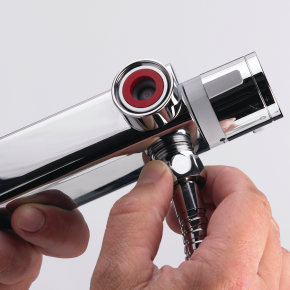
Stemming the flood – water efficiency in the home: A Bristan article
This article sees Chris Tranter, senior product manager at Bristan, look at the options regarding the clever solutions for balancing a satisfying bathroom experience with water efficiency.
With householders becoming increasingly aware of the efficiency of their homes, one of the core considerations within this is water usage. Many Brits prioritise multiple bathrooms and high-powered fixtures when looking for a new property, and as a consequence, our water bills are rising.
Environmental considerations and energy efficiency are a key part of building design and increasing awareness around these issues has led to a rise of a conscious consumer that takes an interest in green concerns such as water efficiency and sustainability.
In fact, according to the Environment Agency, the UK is facing water supply shortages by 2050 unless decisive action is taken now to reduce water use and wastage.
As a result, buyers are increasingly interested in the efficiency of a home’s water delivery products. If specified early-on, water saving options can be assessed and the most appropriate models selected and installed. If left to a later stage, the decision may be rushed and less efficient products chosen as an after-thought.
Also, housebuilders need to be aware of not only the most environmentally-friendly products, but also the cost-saving credentials of these. Essentially, if fixtures can be sourced which tick the boxes for both sustainability and cost-effectiveness, housebuilders can not only make responsible selections, but keep homeowners happy too.
So, what are the best water-saving, cost-efficient options?
The key is to balance customer requirements in terms of performance and water saving. One popular option is a flow regulator, which is included (as standard) in the design of certain models of taps and showers. These work by limiting the flow inside the connection, reducing water without making a significant impact on end user experience.
To put this into perspective, most standard showers distribute a flow rate of 13.5 litres per minute, whereas flow regulated showers offer a rate of 10 litres per minute – delivering significant water savings over the course of the year.
Another option is to fit a tap that offers subtle resistance at the halfway point, raising the user’s awareness of the flow. The good thing with both these options is that performance is not compromised.
As water scarcity becomes a bigger issue, it is imperative that greater measures are taken to ensure we minimise water waste. For housebuilders, making the case for water-saving products is not always a simple task, but by focusing the financial benefits of these solutions alongside their sustainability traits, a solution can be reached which is both environmentally responsible and householder-friendly.
Latest news

18th April 2024
Abloy UK showcases new digital portfolio at The Security Event 2024
Abloy UK is set to unveil its latest line-up of access control systems at The Security Event 2024, welcoming guests to explore its cutting-edge electromechanical and digital solutions on stand 5/F50.
Posted in Access Control & Door Entry Systems, Architectural Ironmongery, Articles, Building Industry Events, Building Industry News, Building Products & Structures, Building Services, Doors, Exhibitions and Conferences, Facility Management & Building Services, Health & Safety, Information Technology, Retrofit & Renovation, Security and Fire Protection
18th April 2024
Strand is a Failsafe Choice for Emergency Exit and Panic Hardware
In times of emergency, you’re in safe hands with Strand Hardware. Although there are many considerations for building specification, few decisions can be as critical as selecting the right emergency exit/panic hardware.
Posted in Access Control & Door Entry Systems, Architectural Ironmongery, Articles, Building Industry News, Building Products & Structures, Building Services, Doors, Facility Management & Building Services, Health & Safety, Restoration & Refurbishment, Retrofit & Renovation, Security and Fire Protection
18th April 2024
MRA appoints Callum Budd as Research Projects Director
MRA Research, the research agency focused solely on the construction sector, welcomes Callum Budd as its new Research Projects Director.
Posted in Articles, Building Industry News, Information Technology, news, Recruitment, Research & Materials Testing
16th April 2024
Mitsubishi Electric set to host CIBSE Journal webinar
Mitsubishi Electric will host a CIBSE Journal webinar on Wednesday 24th April 2024 at 1pm to discuss the legislation and initiatives driving changes in the way we will need to heat, cool and ventilate large commercial buildings to reach net zero emissions in the UK.
Posted in Air Conditioning, Articles, Building Industry Events, Building Industry News, Building Products & Structures, Building Regulations & Accreditations, Building Services, Facility Management & Building Services, Heating Systems, Controls and Management, Heating, Ventilation and Air Conditioning - HVAC, Information Technology, Pipes & Fittings, Plumbing, Seminars, Sustainability & Energy Efficiency, Training
 Sign up:
Sign up: